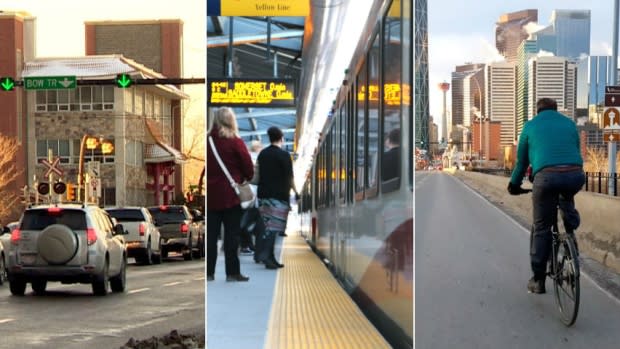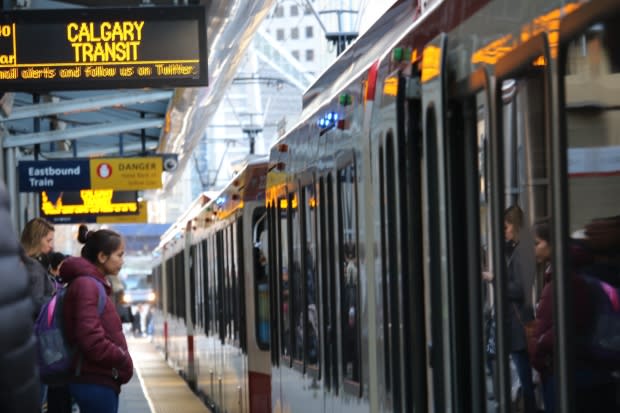The car is still king in downtown Calgary, despite growth in transit and cycling

For a few weeks every May, a small army of city workers surrounds downtown Calgary.
They sit at their posts, in shifts, for 16 hours a day. They watch the roads. And they count.
With lightning-fast reflexes, they tap buttons on custom-built, handheld devices. Each tap records how many people are travelling in and out of the city's core by automobile, bus, C-Train, bicycle and on foot.
All that information is later downloaded into a giant database, which gives us the most precise picture we have of Calgarians' travel habits — and how those habits change over time. And a few trends have emerged.
When it comes to all-day travel, cars still rule the roads. During rush hour, though, it's a different story. Transit has usually been the top choice at peak travel times. Cyclists, meanwhile, represent the smallest segment of downtown commuters — but also the fastest growing, by far.
We know all this thanks to that army of traffic counters, furiously tapping away at those buttons.
So let's take a closer look at their work, and what it tells us about Calgarians' daily lives.
Transit rebounds after recession
Whenever a bus or C-Train goes by, the traffic counters are trained to quickly eyeball the vehicle and gauge how many people are on board. Is it a quarter full? Half full? Packed?
Knowing the capacity of the buses and trains, they can then estimate the number of riders. It's not a perfect count, but it's more accurate than any other measure we have.
And, for a few years in a row, they were counting fewer and fewer people.
Back in 2014, a slim majority of rush-hour commuters were taking transit. The following year, that fell below 50 per cent. The year after, it was down to 45 per cent.
By 2017, transit use had fallen closer to 41 per cent and, for the first time in years, buses and C-Trains were supplanted by cars and trucks as the No. 1 choice for peak-hour commuters.

"We did see a pretty significant dip during the heart of the economic downturn," says Nikhil Lobo, the city's manager of transit planning.
He believes this was likely connected to the rise in unemployment at the time. Fewer people working downtown means fewer people taking transit downtown.
And not just during rush hour.
All told, the number of daily transit riders observed during the entire 16-hour count (from 6 a.m. to 10 p.m.) fell from 249,000 in 2014 to 189,000 in 2017.
Ridership has since started to rebound, however. In 2018, it was back up to 220,000.
Compared to other travel modes, transit also regained the rush-hour lead this year — but just barely.

You'll note from the pie chart above that the overwhelming majority of commuters are travelling by a motor vehicle of some kind, whether it's cars, buses or C-Trains.
Only about one in 10, by contrast, are travelling on foot or by bike.
And cyclists, in particular, make up the smallest group of commuters, at just 3.7 per cent.
But their ranks have been growing faster than anyone else.
Impact of cycle tracks
Back in 2012, cyclists represented an even smaller share of Calgarians making their way downtown during the morning rush hour: only 2.2 per cent.
But something happened that year that Blanka Bracic believes set a larger shift in motion.
"What really started to change things was the Peace Bridge," says Bracic, the city's acting manager of liveable streets.
"And then, after that, came the Seventh Street S.W. cycle track. And that enabled us to start talking about the downtown cycle-track network. And once we opened that network in 2015, we saw the number of bike riders coming into the downtown go up quite a lot."
The shift toward cycling happened not just during rush hour, but at all times of day.
When you look at total trips for the full 16-hour period that the traffic counters study, cycling has seen the largest recent increase, by far.
The number of people riding bikes in and out of downtown is up by more than 50 per cent since 2012. By comparison, transit ridership and car travel is down, slightly, over that same time.
This next graph shows the growth (or decline) in cyclists, transit users, car occupants and pedestrians, compared to how many of each type were counted in 2012.

Ekke Kok, the city's manager of transportation data and forecasting, says trends like this are "the most interesting part" of the traffic-count study for "a data guy" like him.
"I think the cycle tracks are a great example of where you can see a trend and then you can point to something that happened and say, look, this influenced that trend," he says.
Cycling may be the stand-out statistic, when you look at this data in terms of changing trends.
But, in terms of sheer numbers, cars still dominate downtown roads.
Car use down but still dominant
In 2018, there were 373,000 people in automobiles counted either entering or exiting downtown between 6 a.m. and 10 p.m.
That's up ever so slightly from the 369,000 counted last year, but still below the annual average of 379,000 counted since 2012.
Still, it makes cars and trucks the most popular choice for all-day downtown travel.
Compare that to the aforementioned 220,000 daily transit users measured during the latest 16-hour count. Pedestrians numbered 69,000 in that same count, and cyclists 18,000.

Compared to the rush-hour numbers, Kok says the 16-hour counts tend to skew toward automobiles.
"If you do it over 16 hours you get a lot of other traffic as well, such as delivery trucks, and so on," he says. "The morning peak tends to focus a little more on the commuter."
For that reason, he tends to focus on the peak-hour counts when comparing commuting habits, in particular.
The 16-hour counts, by contrast, offer a picture of total downtown travel throughout the morning, afternoon and evening.
Transit and cycling may be catching up in that regard — but, in this city, the car is still king.
Calgary: The Road Ahead is CBC Calgary's special focus on our city as it passes through the crucible of the downturn: the challenges we face, and the possible solutions as we explore what kind of Calgary we want to create. Have an idea? Email us at calgarytheroadahead@cbc.ca
More from the series:

